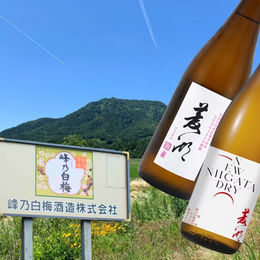
Tsuchida is a sixth-generation family-owned Sake brewery established in 1907 in the Gunma Prefecture. Gunma is a mountainous region in the northwest of Tokyo, known for its nature and by extension nature activities ranging from hiking to whitewater rafting, and for the less active, it's got great onsen too.
Tsuchida itself boasts a comparatively young staff, most of whom are in their 30's, and yet much of its efforts have been focused on producing Sakes that harken back to a more ancestral period. It is one of the few breweries that work fully off the ancient Kimoto method of producing its yeast starter with the combined ingredients of a heap of laborious effort and ambient yeast, but perhaps more interestingly, it runs counter to the Sake category's massive focus on achieving ridiculously high rice polishing ratios.


Modern Sake has the tendency to believe that polishing rice so much that only a minuscule fraction is left is key to making great Sakes. This is thought to ensure the purity in the ensuing Sake as only a very consistent core part of the rice grain - the shinpaku - is left. By removing the less starchy outer parts of the rice and leaving only the most core starchy parts, the Sake is thereby more singular.
Yet, Tsuchida doesn't believe in that. Instead Tsuchida believes that the traditional methods (including Kimoto) are the most pure version of Sakes, and if in the old days there was no ability to achieve such high polishing ratios, then this would not be necessary even today. Thus Tsuchida is rather upfront with how they prefer to keep more of the outer parts of the rice that they believe gives the Sake more umami and layers of flavour. Nevertheless, the brewery still ends up with a twice as long Sake production time because of the Kimoto method used (more than compensating for any time saved from not polishing their rice as much).

Today we're going to try the Tsuchida K. The "K" here refers to it being a Kijoshu type of Sake, which can be thought of as a dessert Sake, usually sweeter and more dense. This is a result of a specific deviation in the way the rice mash (the moromi) is worked. In yet another example of Tsuchida employing traditional methods, the brewery uses a three-step method to making its rice mash called Sandan-Shikomi.
This means that the rice mash is built up over several days, layer by layer in three key steps, almost like making a bakery making a cake - this is a tedious process but is thought to yield more flavourful and robust flavour as the yeast is allowed to "digest" and "grow" before more input is given, as opposed to creating the mash all at once which is thought to overwhelm the yeast. In a way, this process fortifies the potency of the yeast.

In the case of Kijoshu, the last step which would have ordinarily involved adding water to the rice mash, Sake is used instead. While this process creates a flavourful and rich Sake, it also simultaneously creates a grey zone in the Sake classification system. Because additional Sake is added, while not being Brewer's Alcohol (which is not Sake), the resulting Sake is thereby disqualified from Junmai status wherein only rice, yeast, koji and water is used. However, we can't be too quick to call this not Junmai either - after all it is yet another rice-based alcohol that is being added to the fold - therefore Kijoshu is typically considered a class of its own. As Tsuchida prides itself on only producing pure rice Sakes, the Tsuchida K does nevertheless fall within that category.
Tsuchida goes on to say that the "K" actually stands for "Knot", as in to connect and bind, in reference to connecting people to alcohol, alcohol to food, and people to people. Here the rice polishing ratio is 90%, which is by Sake standards, really removing just the surface layer of the rice, and if we're talking rice, the rice here is sourced locally from the Gunma Prefecture.
With that let's give it a go!
Tsuchida K Junmai, 17% ABV | 土田 Tsuchida K - Review

Tasting Notes
Color: Darker Chardonnay
Aroma: Really warm, deeper autumnal notes, almost syrupy even - brown sugar syrup. It’s also layered with herbal florals of chrysanthemum, aiyu jelly, rock sugar, Pei Pa Koa cough syrup. It has an almost lifted, grassy, herbal, sweet and deep aroma. Over time it turns more confectionary, with notes of light cherry and cotton candy.
Taste: Gentle, mellow, earthy, grassy sweetness. Again with the herbal flavours of brown sugar, sea coconut jelly, chrysanthemum tea. It’s pretty consistent with its aromas, with also that floral perfumery note.
Finish: More on lingering spice, with alittle bit of anise, and then back to that herbal, brown sugar sweet jelly.

My Thoughts
Absolutely lovely! This was a big favourite for me with those mellow, deeper, darker, sweeter floral herbal flavours. This had alot of depth and of course a lovely thicker, almost syrupy texture. It was like a herbal Chinese dessert reminiscent of Cheng Tng or Aiyu Jelly.
So much depth, silkiness and rounded mellowness - ridiculously tasty!
My Rating: 10/10
Score/Rating Scale :
- 9-10 : Exceptional, highly memorable, 10/10 would buy if I could.
- 7-8 : Excellent, well above most in its category, worth considering buy-zone.
- 4-6 : Good, okay, alright; a few flaws, but acceptable; not bad, but not my personal preference; still worth trying, could be a buy if the price is right.
- 1-3 : Not good; really did not enjoy; wouldn't even recommend trying.
- 0 : Un-scored, might be damaged, new make, or very unusual.
Kanpai!

@111hotpot







